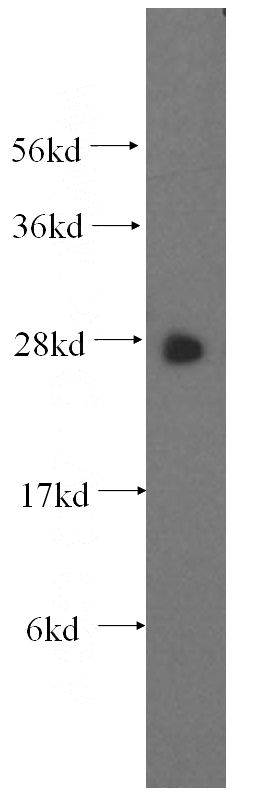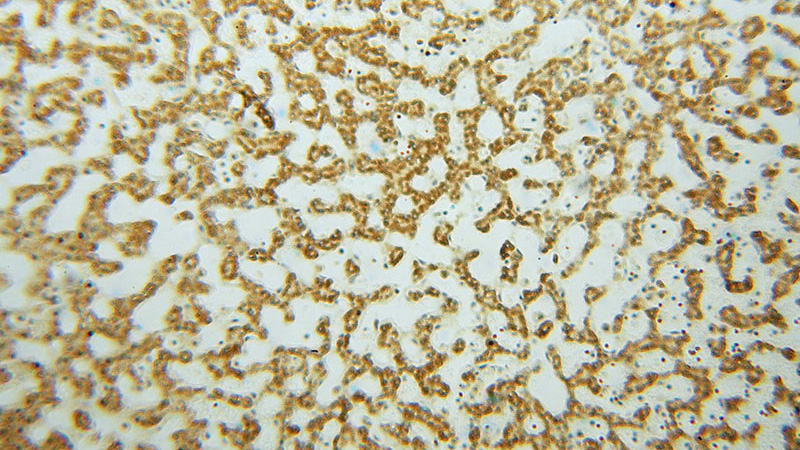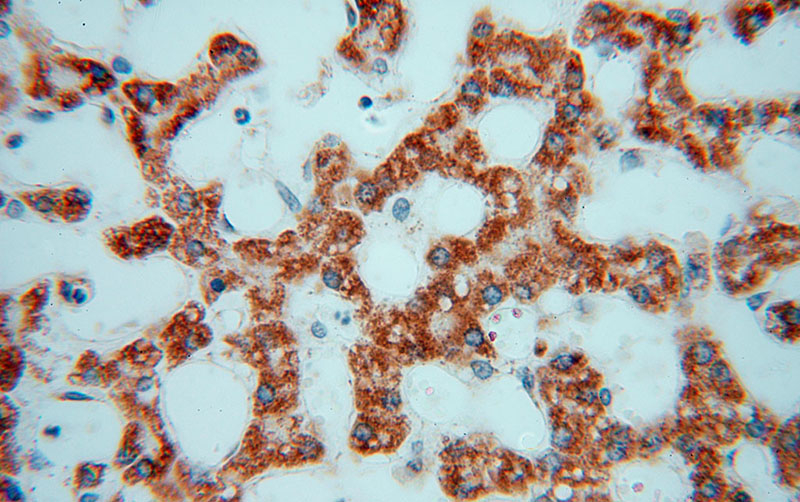-
Product Name
GSTT1 antibody
- Documents
-
Description
GSTT1 Rabbit Polyclonal antibody. Positive WB detected in human brain tissue, HepG2 cells, mouse brain tissue, mouse liver tissue, rat liver tissue. Positive IHC detected in human liver tissue, human brain tissue, human heart tissue, human kidney tissue, human lung tissue, human ovary tissue, human skin tissue, human spleen tissue, human testis tissue. Observed molecular weight by Western-blot: 28 kDa, 30 kDa
-
Tested applications
ELISA, WB, IHC
-
Species reactivity
Human,Mouse,Rat; other species not tested.
-
Alternative names
Glutathione transferase T1 1 antibody; GST class theta 1 antibody; GSTT1 antibody
-
Isotype
Rabbit IgG
-
Preparation
This antibody was obtained by immunization of GSTT1 recombinant protein (Accession Number: NM_000853). Purification method: Antigen affinity purified.
-
Clonality
Polyclonal
-
Formulation
PBS with 0.02% sodium azide and 50% glycerol pH 7.3.
-
Storage instructions
Store at -20℃. DO NOT ALIQUOT
-
Applications
Recommended Dilution:
WB: 1:500-1:5000
IHC: 1:20-1:200
-
Validations

human brain tissue were subjected to SDS PAGE followed by western blot with Catalog No:111192(GSTT1 antibody) at dilution of 1:500

Immunohistochemical of paraffin-embedded human liver using Catalog No:111192(GSTT1 antibody) at dilution of 1:50 (under 10x lens)

Immunohistochemical of paraffin-embedded human liver using Catalog No:111192(GSTT1 antibody) at dilution of 1:50 (under 40x lens)
-
Background
GSTT1 belongs to the GST superfamily and Theta family. It is a conjugation of reduced glutathione to a wide number of exogenous and endogenous hydrophobic electrophiles. GSTT1 acts on 1,2-epoxy-3-(4-nitrophenoxy)propane, phenethylisothiocyanate 4-nitrobenzyl chloride and 4-nitrophenethyl bromide. It displays glutathione peroxidase activity with cumene hydroperoxide. GSTM1 and GSTT1 has been suggested as a risk factor in various cancers. GSTT1 is important in the detoxification of unidentified xenobiotics in the large intestine.
-
References
- Arakawa S, Fujimoto K, Kato A. Evaluation of hepatic glutathione transferase Mu 1 and Theta 1 activities in humans and mice using genotype information. Drug metabolism and disposition: the biological fate of chemicals. 40(3):497-503. 2012.
- Sato Y, Kubo S, Takemura S. Different carcinogenic process in cholangiocarcinoma cases epidemically developing among workers of a printing company in Japan. International journal of clinical and experimental pathology. 7(8):4745-54. 2014.
- Gi M, Fujioka M, Yamano S. Determination of Hepatotoxicity and Its Underlying Metabolic Basis of 1,2-Dichloropropane in Male Syrian Hamsters and B6C3F1 Mice. Toxicological sciences : an official journal of the Society of Toxicology. 145(1):196-208. 2015.
- Gi M, Fujioka M, Yamano S. Modifying effects of 1,2-dichloropropane on N-nitrosobis(2-oxopropyl)amine-induced cholangiocarcinogenesis in male Syrian hamsters. The Journal of toxicological sciences. 40(5):647-56. 2015.
- Zhang L, Zong C, Ichihara S. A trial to find appropriate animal models of dichloropropane-induced cholangiocarcinoma based on the hepatic distribution of glutathione S-transferases. Journal of occupational health. 57(6):548-54. 2015.
Related Products / Services
Please note: All products are "FOR RESEARCH USE ONLY AND ARE NOT INTENDED FOR DIAGNOSTIC OR THERAPEUTIC USE"
